Introduction

Is your email program generating at least 23% of your total Ecommerce revenue?
That's the average we've seen across industries, with certain top-performing brands generating over 50% of their revenue from a robust email marketing program. Email may be one of the old schools of the digital marketing world, but it continues to perform well for brands year after year. In 2019, email marketing’s return on investment was 42:1 on average, up from 38:1 the previous year, according to Litmus’ 2019 State of Email Survey.
The inbox, though, has become increasingly competitive, so you'll need to devise a strategic email marketing program to stand out from the competition.
Luckily, this Ultimate Guide to Ecommerce Emails is the perfect handbook to guide you through developing that masterful email program.
In this guide, we’ll tell you the best ways to:
- Set up your email marketing infrastructure
- Grow your email list
- Create engaging emails
- Create a content calendar
- Automate your emails
- Segment and optimize your emails
- Calculate your email marketing ROI
- Email marketing laws
- How to choose the right email marketing agency
Set Up Your Email Marketing Infrastructure
Technology
Choose Your Email Service Provider (ESP)
Email service providers such as Gmail and Outlook limit the number of emails you can send each day and the number of recipients per message. This, in return, protects recipients from spam and email abuse. Therefore, companies need a service provider that will allow them to legally email large groups of recipients. Email Service Providers (ESPs) do just that.
ESPs provide a range of services for sending bulk email marketing campaigns to a list of users. At the very core, ESPs provide email templates, help you send emails, and analyze the results. Some of their advanced features include email automation, optimized deliverability, advanced segmentation, and legal compliance.
What to Look For in an ESP
What you should look for in an ESP depends very much on the size and the needs of your company. A good ESP should be able to provide you with:
- Order data syncing: You should be looking for an ESP that offers tight order data syncing with your web store so that all data passing into the platform can be utilized in segmentation targeting down the road.
- Stability of core integrations: High stability of core integrations is essential because you can have as much functionality as you want from the ESP, but if it’s unstable, it’s going to affect your email marketing workflow and have a negative impact on performance levels.
- A/B testing functionalities: Testing is one of the foundations of a successful email marketing program. The more testing functionalities your ESP provides, the better you’ll get to know your audience and implement effective segmentation.
- Reporting: You need to look for a thorough, yet simple reporting system within the platform, as well as simplicity in how you can access and download the data.
- Customer support : As with all software, technical issues arise, and having the necessary support is vital to get the results you want in a timely manner.
Choose Supporting Apps
Now that you have a solid ESP provider for your email program, you should be looking at supporting apps that will work best for you. Important apps include the ones that provide:
- Product review requests: A lot of product review request apps have functionality to send product review request emails and allow the user to fill out the review directly from the email.
- Loyalty/Referral programs: Loyalty and referral apps can help you to integrate rewards and referral data in your automated, targeted emails.
- Pop-ups: These apps give you the ability to target with your pop-ups, show pop-up captures, sculpt the different elements of user experience on the site, and send different messages there, which in the end drives list growth.
Deliverability
The next thing you need to ensure is that the deliverability of your email program is strong. Deliverability measures the rate at which your emails get delivered. It means that your emails should be delivered to inboxes of your recipients and not end up in spam folders (or not delivered at all).
Why Should You Care
Ruth Patel’s 2018 Deliverability Benchmark report shows that 15% of all emails don’t get delivered. So if you are sending to a list of one million subscribers, 150,000 people will never receive your message. This can significantly affect email revenue, but it can also impact customer relations by stopping transactional emails, such as order confirmations and shipping notifications, from being delivered.
Furthermore, deliverability is becoming harder, especially with actions taken by Gmail and other ISPs. Namely, email providers are getting sophisticated with measuring user engagement and behavior to impose more stringent criteria on how much of your mail gets delivered.
Deliverability Best Practices
1. Authentication Setup: Setting up SPF, DKIM, and possibly DMARC should be your first step toward ensuring email deliverability. There are multiple authentication frameworks in place used by ISPs to determine if the email is coming from the legitimate sender. Several key infrastructures used are:
- SPF (Sender Policy Framework) is a security measure that makes sure nobody sends emails to anyone on your behalf, so it’s very important to set this up on your Domain Name System (DNS) server.
- DKIM (DomainKeys Identified Mail) is similar to SPF, but it’s preferable to set it up on your DNS server as an additional measure. The idea behind this key is that there are two sets—one that is unique to your domain and encrypts your signature (this happens in the header of your email), and one that is public, necessary for decrypting your signature.
- DMARC unifies SPF and DKIM to a shared framework. It allows domain owners to declare how they would like email from that domain to be handled if it fails an authorization test.
Luckily, your email service provider will likely handle most of these authentication processes for you, or will be able to help you set them up.
Note that you need to keep up with new standards that come into play, such as BIMI (Brand Indicators for Message Identification), which safeguards the brand, application providers, and consumers from impersonation attempts.
2. Seek Permission: Whether you are capturing emails at checkout, through a site overlay, or some other source, you need to explicitly ask for permission. The more aware your contacts are that they are being opted in to your list, the lower are the chances they will automatically press that spam button or ignore your emails. Laws are being increasingly restrictive in terms of explicit permission—check out the email marketing laws section of this guide for more information. In general, make sure to get some form of permission before sending marketing messages to your contacts.
3. Maintain a “Clean” List: Keeping a clean list is integral to protecting your reputation in the eyes of the inbox providers, which will help maintain strong deliverability for your email program.
Essentially, maintaining a clean list means following best practices, such as suppressing inactive contacts, getting deliberate opt-ins, segmenting the frequency of your sends, and sending compelling and relevant content to your list.
4. Regularly Monitor Your Deliverability: Deliverability is not an one-off action. Because so many factors are at play, you will inevitably see fluctuations in your deliverability. This is why it’s important to do regular check-ups on your current status to make sure you catch and diagnose problems early on.
5. Throttle Your Mail: As mentioned before, throttling your mail on individual sends can help improve your deliverability. Throttling means that instead of sending all of your email at once to your list, you are sending it over a period of time (4 hours, for example), so that the ISPs are seeing a more steady trickle of emails instead of one huge spike.
6. Make Sure Your Content Is Clean: Spam trigger words, too many images, and large file sizes can all trip spam filters. Keep an eye on minimizing these spam triggers in your campaigns—most ESPs have some form of a built-in tool to help with this.
7. Never, Ever Buy a List: Just don’t do it. Ever.
8. Don’t Bury Your Unsubscribe Link: You don’t have to advertise your unsubscribe link loudly, but you need it to be clear. Not only is an unsubscribe link required by CAN-SPAM law, it can also help your deliverability. Remember, unsubscribes do not count against you, but if you make it overly difficult for your contacts to unsubscribe, they may default to the spam button instead, which will definitely hurt your deliverability.
9. Be Consistent In Your Sending: Just as consistency in business helps establish your reputation as a business person, consistency in your email sending helps solidify your sender reputation. In general, aim to be consistent in your from name, sender domain, send volume, etc.
10. Use a Private Sub-Domain: Using a private sender sub-domain, such as email.mystore.com, can help establish your domain-level reputation. ESPs will usually provide a default sender domain if you don’t have a private sub-domain, but remember that these won’t be transferable if you ever decide to switch providers.
11. Consider Using a Dedicated IP: If you are sending a good amount of volume and have the guidance to maintain a dedicated IP, you should consider switching over. With a dedicated IP, you’ll have full control of your own sender reputation without worrying about it being tarnished by other senders’ bad practices.
Grow Your Email List
One of the key ways to improve your email marketing is to grow your email list quickly and cleverly. There are a few ways to do so:
1. Check out Email Capture
The best way to build a base for your email list is to make sure you are capturing emails from your new customers during the checkout process. You should have an opt-in checkbox so that they can subscribe to your marketing emails.
Keep in mind that the laws for what is acceptable differ from one country to another. Having a pre-checked opt-in box for maximum emails captured is what we recommend (if your country allows it).
2. Pop-Up Website Overlay Form
Another fantastic way to grow your email list is to implement a pop-up website overlay form. Yes, they can be annoying and ineffective, but if cleverly used, pop-ups see conversion rates as high as 50.2%.
To make sure you are not overexposing your visitors to the pop-up, we recommend utilizing a set of logic conditions. A sample set of conditions:
• New Visitors Only AND
• Time on Page > 45 seconds AND
• Visited at Least 3 Pages AND
• Had Exit Intent
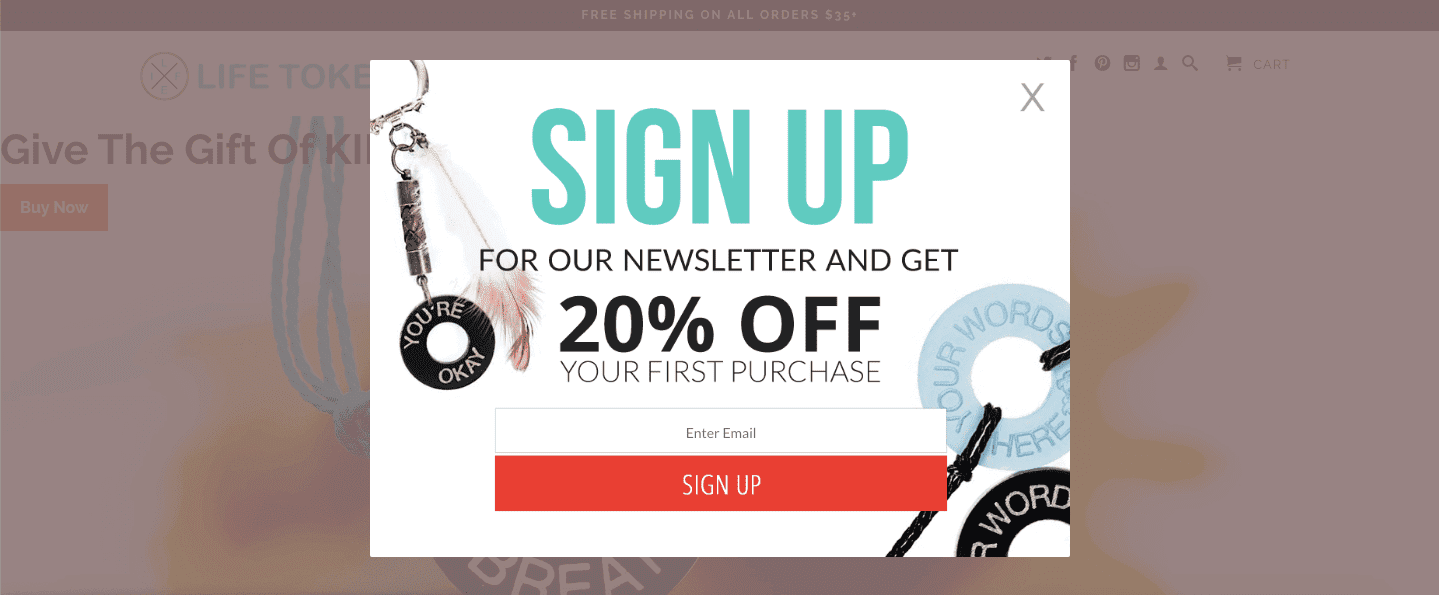
3. Sweepstakes or Virtual Giveaways
Giving prospects a chance to win a prize is a proven way of increasing the number of signups. Facebook and Instagram are a good place to effectively run sweepstakes, such as contests and giveaways. We recommend you partner with another company with which you can create fascinating prize packages that will be worth submitting your email.
As the campaign ends, it is important to prevent yourself from the post-contest unsubscribes. Do this by showing them the value they’ll provide by remaining subscribed.
4. Try Locking Your Content
This means that you’re blocking a part of the content until a user subscribes. To do this, first check your Google Analytics to see which are the most visited blog posts, and then use the gated content marketing method on the most popular or relevant articles for the visitors. This is a useful technique if you’re providing important content which gives value, and users will be obligated to subscribe.
5. Content Incentive
Another popular way to garner email signups is by using a piece of content as an incentive to sign up. These could include an eBook, video series, inside information, etc. The key is to make sure the ROI on these prospects is positive, since someone interested in information isn’t necessarily an actual customer of your product.
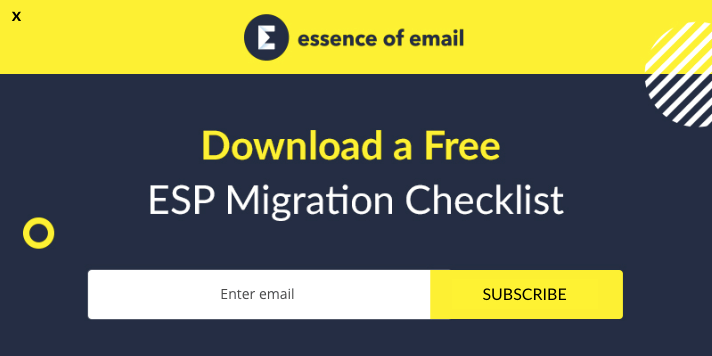
6. Discount Coupons in Exchange for a Subscription
If your website includes some type of ecommerce, you can offer a discount voucher for their first purchase. This is usually done by emailing a coupon code for the subscription. This is a great way to grow your email list, but make sure you’re prepared to retain the gained users afterwards.
7. Live Events
If you run any sort of live events, such as trade shows or pop-up shops, you should consider capturing people’s email addresses when they stop by your booth. Remember to follow up with them shortly after the event so they don’t forget about signing up.
As you grow your email list, you will be able to take your potential customers through the funnel and turn them from subscribers into sales-ready leads.
8. Grow Your List with Social Media
If your ecommerce shop target audience is on social media, you’d better get those followers on your email list. Otherwise, you risk losing them if the social media platform becomes unpopular, your profile gets blocked, or your social media pages start having low engagement rates.
After a few months of compiling data and tracking results of email marketing activities for Essence of Email clients, we created an eBook to help ecommerce shop owners and managers grow their email lists with Twitter, YouTube, Instagram, Facebook, and Pinterest. Download your free copy now.

Create Engaging Emails
The ability to create effective copy for your emails is crucial for boosting your business. An original email can speak volumes, especially if you are an online retailer.
Design Your Email Templates
Key elements to consider for email templates include:
- Email architecture: layout elements, header navigation, footer navigation, and image placement
- Cross-client rendering: testing across different browsers and email clients
- Mobile responsiveness: making sure your emails are mobile-responsive
Email Architecture
Having the optimal layout for your email templates will drive the most click-throughs and ultimate conversions from the campaigns. While we cannot nail down a strictly optimal template to begin with (incremental A/B testing of the elements will yield improvements), there are some tried and true elements to include in a good ecommerce email template.
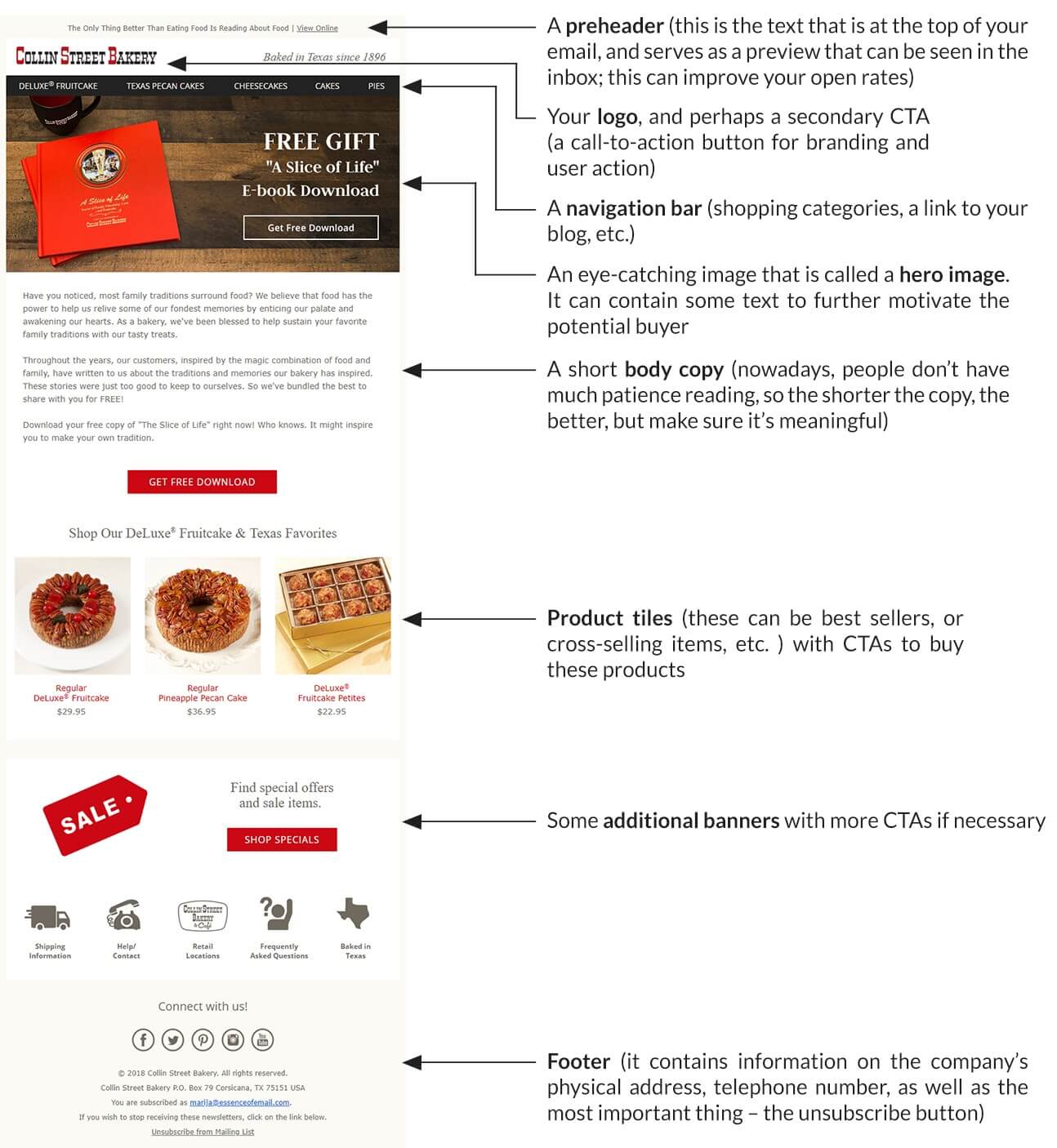
Mobile Responsiveness
Mobile design involves designing emails for optimized views and clicks on mobile devices like smartphones and tablets.
Why Mobile Design is Important
Mobile devices have overtaken the world of marketing, and email marketing is no exception. Mobile usage is growing at a staggering rate. For example, 44% of emails are viewed on mobile, which beats both desktop (33%) and web mail (23%) views. Mobile is here to stay, and will only become increasingly more important.
How To Optimize Your Emails for Mobile (Design & Coding)
Responsive Design
At the core, responsive design’s goal is to make your content, whether it’s your website or email, look good on all devices and screen sizes. This means that instead of having a static version of your content (which could look bad on certain devices), it adapts and morphs to best fit the particular screen you are viewing it on.
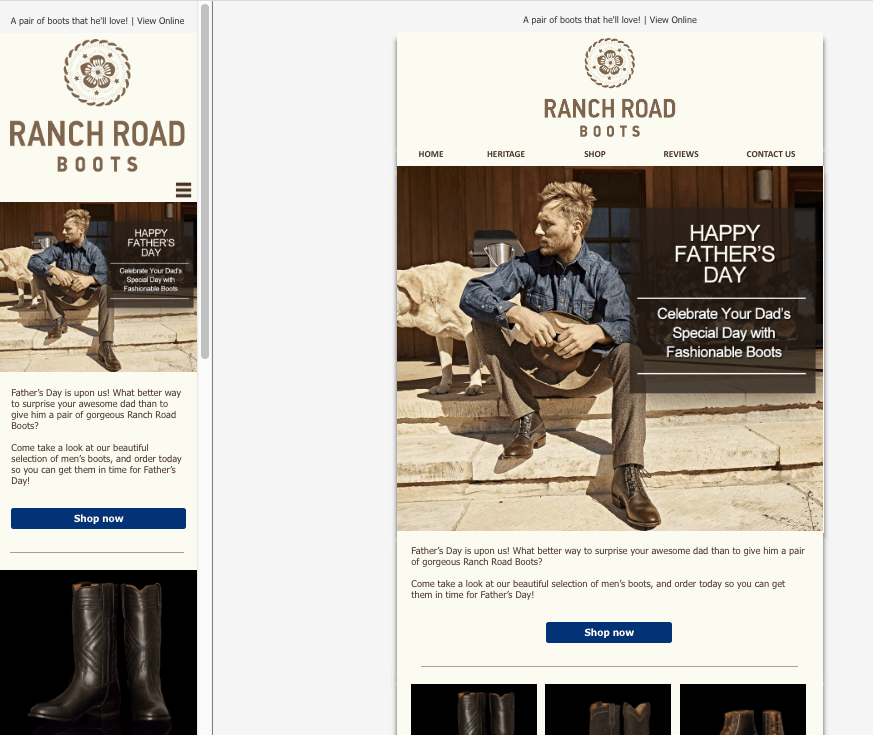
Notice how some of the elements adjust to fill up the screen, the number of non-critical elements is reduced, the sections are stacked, and the font sizes and buttons are magnified for better usability.
Mobile Design Best Practices
- Create clear sections: It’s important to have clear sections in your emails for mobile. Use dividers and other visual elements to portion out the parts of your email.
- Smaller image files: Stick with smaller image files, as there’s restrictions for file size on initial load (for example, the Gmail App loads only 102KB by default)
- Larger font sizes: Utilize larger font sizes; as a rule of thumb, aim for 17-22px (17 for body, 22 for headers)
- Buttons vs. text links: Buttons are easier to click on than text links, especially if your text links are small. Make ample use of buttons, in particular bulletproof buttons (HTML-styled “buttons”). A good practice is to make buttons at least 44px by 44px to help those with large thumbs click more easily.
- Make text links clear: For text links, use text decoration to underline your links. This signals to the user that they are clickable.
- Stack images: Do this so that images take up the whole mobile space and are visible.
- Hide non-essential elements: For example, the header navigation and other less important elements don’t need to be readily visible.
AMP for Email
Back in 2016, Google introduced AMP (Accelerated Mobile Pages) technology that allows the creation of web pages that load almost instantly on mobile phones. In March 2019, Gmail launched general availability of AMP for Email:
“Starting today, we’re making emails more useful and interactive in Gmail. Your emails can stay up to date so you’re always seeing the freshest information, like the latest comment threads and recommended jobs. With dynamic email, you can easily take action directly from within the message itself, like RSVP to an event, fill out a questionnaire, browse a catalog or respond to a comment.” – Aakash Sahney, Product Manager, Gmail, March 2019.
To get an idea of how dynamic emails work in practice, here’s an example of OYO Rooms allowing you to browse hotels and rentals directly from your email:

In addition to Gmail, AMP for email has engagement from major email providers, including Yahoo Mail, Outlook.com, and Mail.Ru, and as they launch support, senders will scale the reach of their AMP emails to users.
Vamsee Jasti, Product Manager, AMP Project, recommend that you start sending AMP emails today:
“Email senders can start creating AMP emails by using the playground which allows you to edit markup and see real-time changes to your email. For more information about the supported features and syntax, head over to amp.dev.”
If you rely on a third party for your emails, make sure they have AMP support. The following email products already support AMP, or are in the process of launching support soon:
- SparkPost, an email delivery and analytics platform
- Litmus, an email design and marketing tools suite
- Twilio SendGrid, an email platform for transactional and marketing emails that is used by over 80,000 companies.
- Amazon SES and Amazon Pinpoint, cloud-based email sending and analytics services for transactional and marketing emails
- More are in progress, so contact your email service providers to find out if they support AMP emails.
Cross-Client Rendering
You need to make sure your emails are rendering well on multiple different email clients/browser combinations. Certain email clients (such as Outlook) tend to break email rendering.
There are a number of services out there that will help you check this. Send a test email to the service platform, and they will let you view what your email looks like in multiple different clients and browsers.
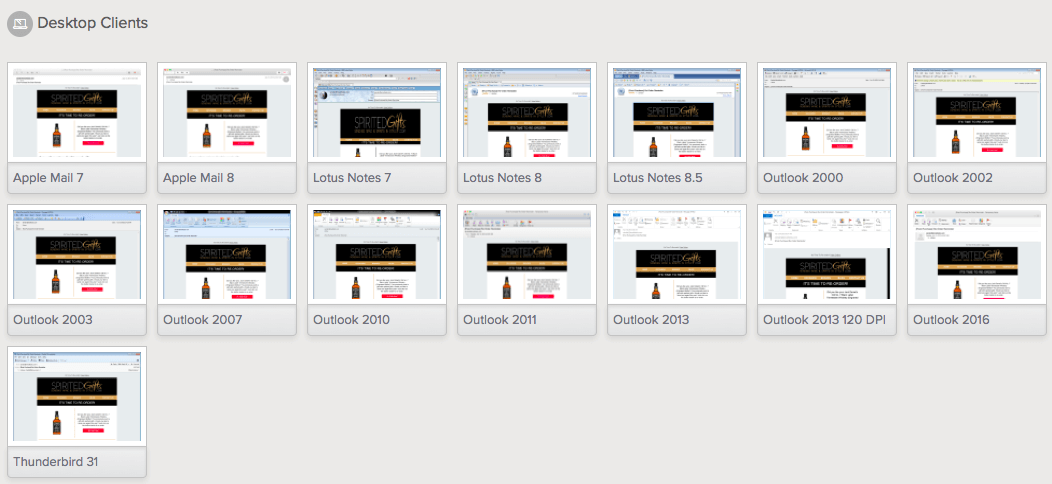
Personalize Your Emails
As subscribers get fatigued by the increasing volume of emails in their inbox, email personalization is no longer a choice for your marketing emails. Nowadays, customers are expecting relevant, tailored, and useful email marketing, which leads to a strong, long-term relationship with brands. Here are our top 5 email personalization tips to increase customer engagement.
1. Start by Using Customer’s First Name
This is the first step of personalization. We like it when someone addresses us by our name because we feel valued.
While the exact syntax varies, most Email Service Providers (ESPs) allow you to automatically show a subscriber’s first name. You can use the first name field in several places in your emails:
- As a part of the email intro, such as “Hello, FIRSTNAME! We’ve missed you!”.
- In the email recipient TO: field, such as “TO: Jess <jess@example.com>”.
- Or, you can include the subscriber’s first name in the subject line.
Using the first name and personalized subject line is not enough. It should be a starting point, but it is important to incorporate the following methods as well.
2. Use Dynamic Content for Effective Personalization
Nowadays, subscribers have low tolerance for irrelevant emails in their inboxes. If you keep sending them emails with products they are not interested in, you risk losing a perfect lead.
Dynamic content is a type of content that helps companies send different emails based on the interests or the past behavior of the clients. It also helps companies save time by sending relevant emails at once to their subscribers.
For example, a global brand could offer a subscriber promoted products from the nearest local shop, based on their location. A brand that offers clothes could have images and text that changes depending on the subscriber’s gender—emails with different content will be sent to men and women.
As your customers learn that your emails are always relevant to them, your click-through rate and ROI will improve and increase.
3. Recommend Products Your Customers Will Love
It would be great if customers bought anything we recommend to them. But in reality, they only buy recommended products that are similar to previously purchased ones, or relevant to their preferences.
With the help of ESPs, you can integrate recent purchases or the browsing history of your customers into your email marketing. By increasing the relevance of your emails, you will see your sales up-scale.
Here is a good visual example of recommended products:
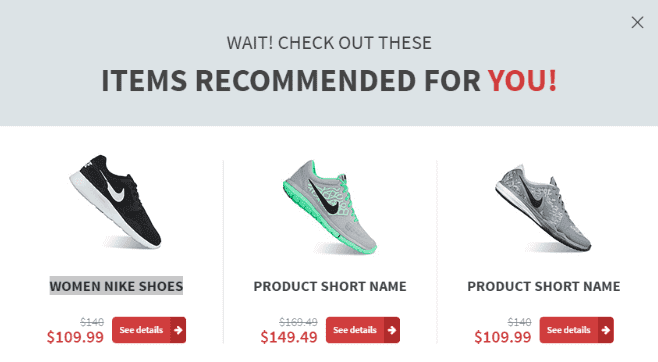
4. Personalize Cart Abandonment Emails
People lose $4 trillion of revenue every year through cart abandonment. The good news is that you can recapture 65% of the customers that left the shopping cart within 24 hours, and emails sent within 60 minutes of cart abandonment have the highest open rate of 40%.
By personalizing your cart abandonment emails, your customers receive the most relevant content and experience. There can be different issues that caused the customer to abandon their shopping cart. Offer a discount on the items in the cart, offer free shipping, or suggest helping them with the process.
This way, you will optimize the message to the highest effectiveness and motivate your customers to recover their carts (your lost sales).
5. Generate Creative Personalized Re-Engagement Emails
It is your duty to identify the inactive subscribers and remind them how great you are in a brief and effective way. Here is your chance to deliver relevant content, accompanied by a personalized offer/incentive to inspire them to re-engage with your brand. Personalized re-engagement emails increase customer retention, and this certainly outstrips the basic engaging messages. Therefore, pick attractive subject lines and send captivating content with a CTA button, and lead your subscribers to an action again.
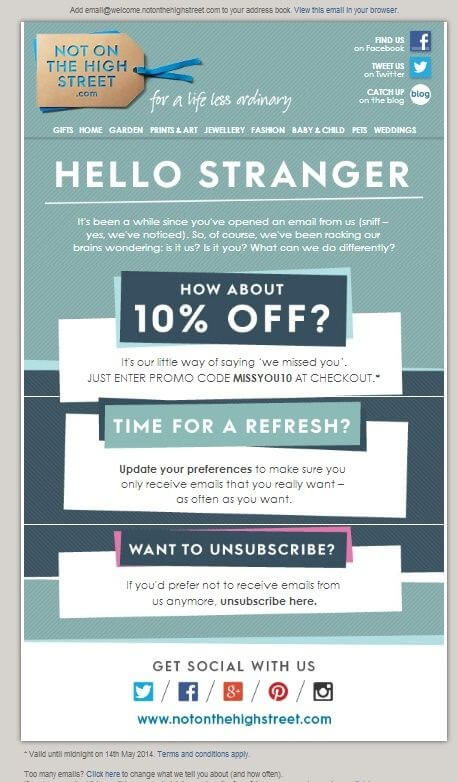
6. Personalizing Emails with Dynamic Content Blocks
Dynamic content blocks are pieces of the email template that display content which changes for different users based on a set of factors. This differs from the typical email templates that are “static”, i.e. not changing, and display the same content to all users.
Create a Content Calendar
When making campaigns, you should make a yearly calendar to know exactly what kind of email you want to send, and when. Your email content calendar should include:
• Holidays: gifting holidays, general holidays, high season
• Events: pop-up shops, contests, news
• Promotions: discounts, shipping offers, flash sales
• Content: blog posts, videos, user-generated content
• Recurring emails: featured products, seasonal category, product of the month
Here’s an example of some of the content your campaign calendar might include:
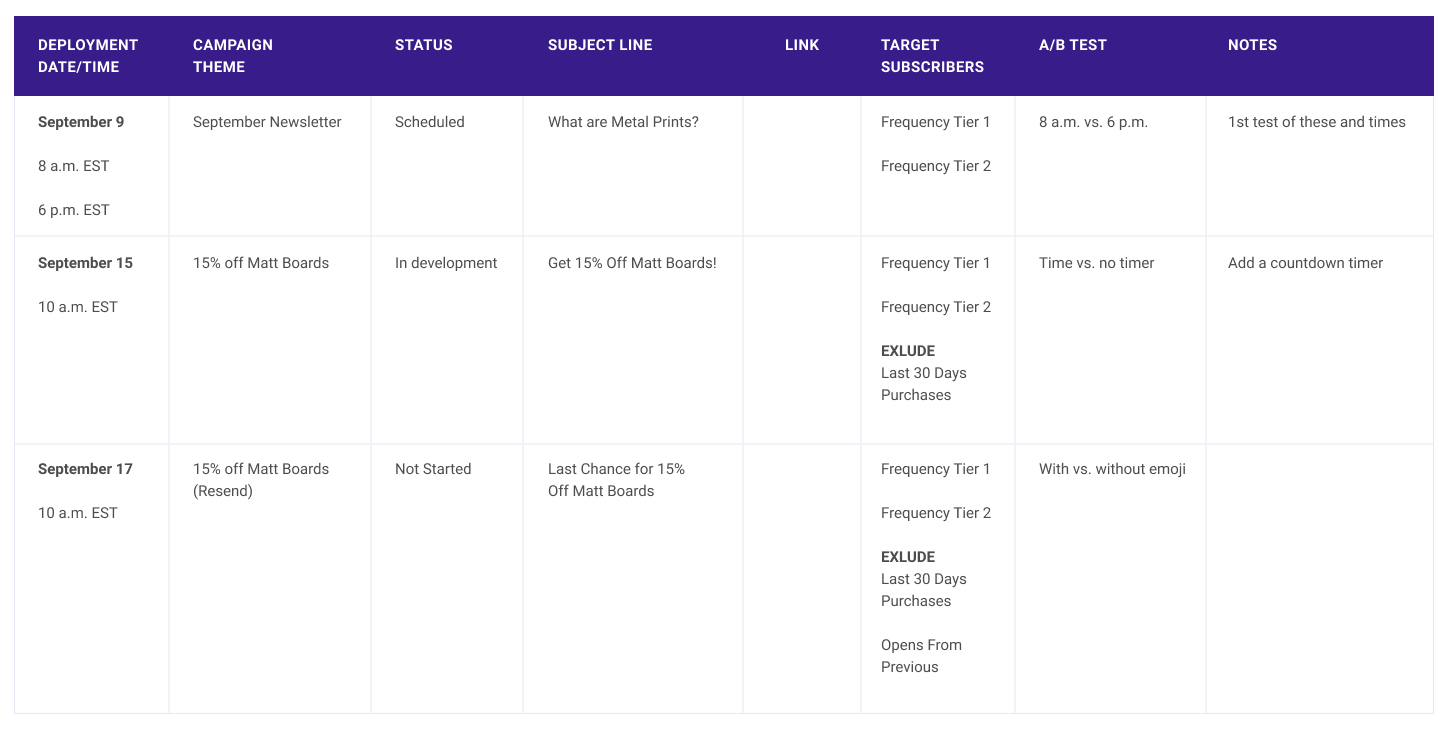
How Often Should you Email Your Subscribers?
A strategic approach to this email sending frequency dilemma is to send at a higher frequency to your most engaged/active subscribers, and at a lower frequency to the less active subscribers.
To find out the right frequency, you’ll need to create tests for different segments. You want to see which segment can sustain higher frequency, and which needs lower frequency.
You should start by sending 4 to 6 emails per month, plus resends. The next step will be to segment your list into frequency tiers based on behavior, such as open rate, click rate, number of emails received, and time since the last order.
If a subscriber becomes disengaged and falls below a tier threshold, he/she will drop to a lower frequency tier. If a user becomes dormant, he/she will join a re-engagement series, and if that doesn’t work, the subscriber will move to a non-engaged group and get suppressed.
Email Resends
Email resends can normally generate 50% of the original email’s revenue. In rare instances, they may even outperform the original email’s revenue.
Resends of email campaigns can be a powerful tool to:
a) get additional revenue from a campaign
b) get an extra send from the same amount of initial work of creating the campaign.
At the core of it, a resend is sending almost the same campaign to a portion of the original target list.
Usually, they have the following characteristics:
- Sent a few days after the original campaign.
- Sent to those subscribers who did not open (most common), did not click (less common), or did not order (uncommon) from the original campaign. In certain instances, resends may go out to the entire original list as well (this is situational).
- Have a different subject line and preheader. Subject lines and/or preheaders may stress a sense of urgency in case of a sale with an expiration date. For example: Don’t Forget, Ends Soon, Last Chance, etc…
- Same or very similar full content of the email campaign to the original campaign.
Automate Your Emails
What Is Email Marketing Automation?
Email Marketing Automation is an ecosystem of tools and mechanisms that helps automate ongoing conversations with customers and maintain delivery of a high degree of personalized content. This allows you to make sure that subscribers receive tailored content they simply want to read.
Why Should I Use Email Marketing Automations?
According to Lenskold and Pedowitz Group, companies who send automated emails are 133% more likely to send relevant messages that correspond with a customer’s purchase cycle. Automated emails significantly affect open and click-through rates, as proven in an Epsilon Email Institute study of 340 million emails across multiple industries. The study showed that triggered emails have a 70.5% higher open rate and 152% higher click-through rate than generic email newsletters.
There are five primary reasons every business should use email marketing automations:
- Highly segmented email lists are automatically updated based on user data
- Conversion of potential customers into actual customers
- Easy, continuous engagement with potential and existing customers
- Increase of efficiency by automating repetitive tasks associated with customer relationship management
- Improvement of engagement by delivering more relevant, personalized, and timely messages to subscribers
How Email Marketing Automations Work
Automated emails are premade emails that are triggered to be sent if your subscriber performed/didn’t perform an action. They are “triggered” by certain events, usually a behavior by a contact—such as making a purchase, abandoning a cart, signing up for a list, etc.
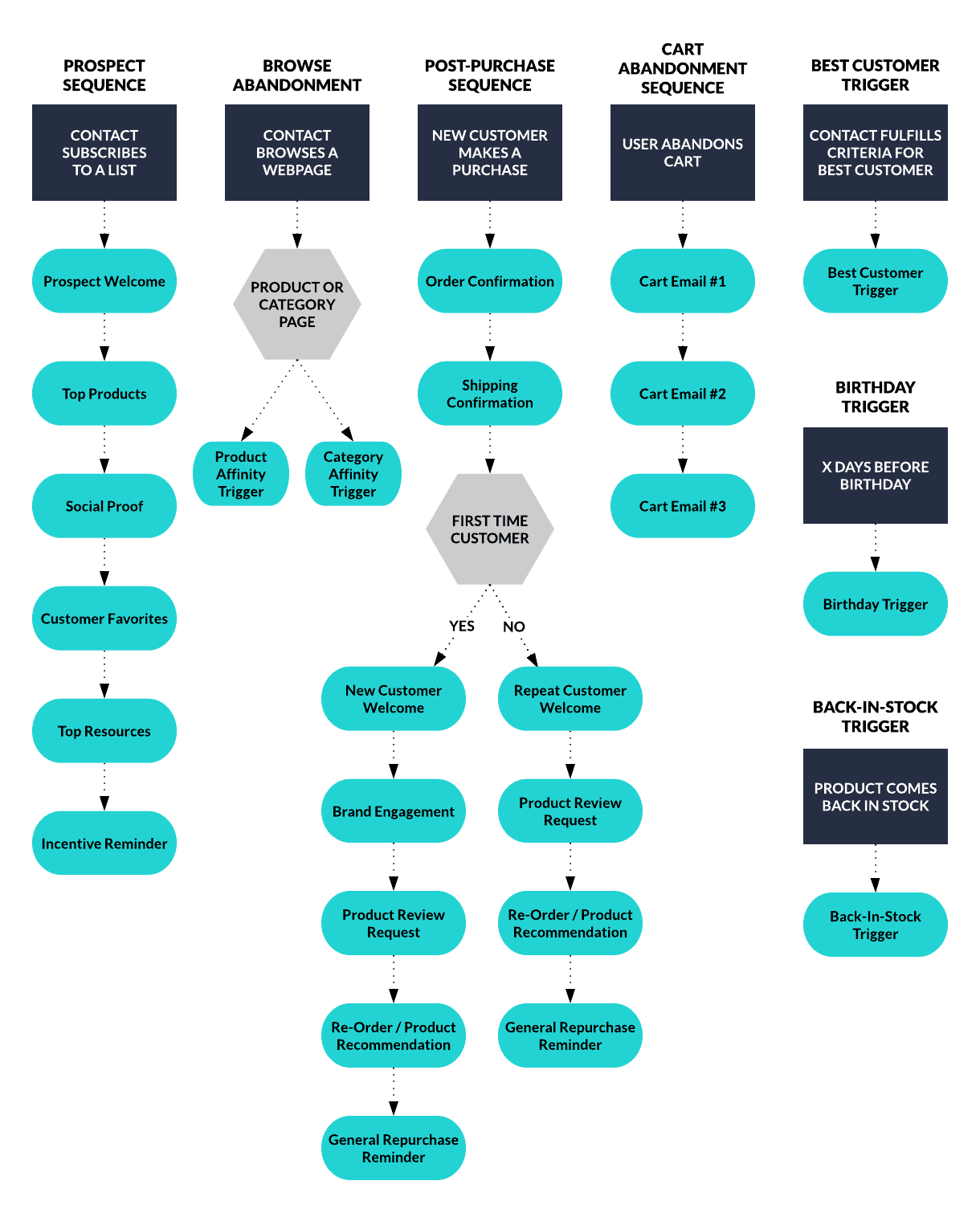
Prospect Sequence
- Prospect Welcome: The top products email is usually part of the prospect series targeted towards noncustomers. The goal is to showcase a set of popular products as a direct CTA to purchase.
- Top Products: This email welcomes your subscribers to your email list. It is targeted towards non-customers, and the focus is to deliver the incentive you used to entice them to give you their email address.
- Social Proof: The social proof email uses the customer testimonials and other user-generated content to boost trust. Instead of directly selling, this email is meant to approach the prospect from a different angle so as to generate enough trust to get the purchase.
- Customer Favorites: A similar concept as the social proof email—you can showcase the products with the most favorable reviews to further cement the buying decision.
- Top Resources: The top products email is usually part of the prospect series targeted towards noncustomers. The goal is to showcase a set of popular products as a direct CTA to purchase.
- Incentive Reminder: The incentive reminder email is the last email in the sequence that again reminds your prospects (those who have not purchased) to use the coupon code incentive to purchase. You can also include an element of urgency in this email to further drive action.
Browse Abandonment
- Category Affinity: The category affinity email is sent to contacts one day after they visit a particular category or subcategory level page on your website. The idea is to target visitors with a follow-up email that displays products within the category they visited on the website, as they are more likely to purchase. This email requires URL tracking ability in your email service provider.
- Product Affinity: The product affinity email is sent to contacts one day after they visit a particular product page on your website. The idea is to target visitors with a follow-up email that displays the product they viewed, as well as related products, as they are more likely to purchase. Requires URL tracking ability in your email service provider.
Cart Abandonment Sequence
The cart abandonment sequence is one of the most effective email sequences within your email marketing arsenal. Businesses regularly see high engagement and conversion rates on shopping cart abandonment emails. It’s not uncommon to see open rates greater than 50% and conversion rates greater than 15% on these emails. The purpose of the cart abandonment email sequence is to send a timely reminder to people who initiated the checkout process on your site, but have not completed the process. The goal is to “save” a portion of the people who would have otherwise abandoned the checkout altogether and never convert.
Post-Purchase Sequence
- Order Confirmation: The order confirmation email is a transactional type of email that is sent right after a contact purchases. While you need to follow the rules for transactional emails (they cannot contain too much marketing), there are still opportunities to drive click-throughs back to your site and recommend products. We often see additional, immediate repurchases coming from the order confirmation.
- Shipping Confirmation: The shipping confirmation email is usually the top-opened email in your arsenal (often opened multiple times by your contacts). Thus, this email is a prime opportunity to drive additional purchases or secondary calls-to-action.
- New Customer Welcome: The new customer welcome email is sent out after the first-time purchase by a new customer. This email is sent immediately, up to one hour after purchase. The goal of the email is to deliver the post-purchase ‘‘thank you’’ message and drive additional actions, such as taking a survey (to obtain data for future segmentation), sharing with friends, and participating in brand advocating activities.
- Repeat Customer Welcome: The repeat customer welcome email is similar to the new customer welcome, except it’s targeted towards repeat buyers. This means the contact has bought at least one time from your store in the past. Thus, the content of the email is geared heavily towards enticing them to help spread the word about your brand, since it’s likely they have more attachment towards your store if they are purchasing more than once.
- Brand Engagement: The brand engagement email is sent a few days after the purchase and is focused on growing your social media subscribers, as well as driving new purchasers to your other content properties, such as your blog, forums, communities, etc.
- Product Review Request: The product review request is sent after the purchase, requesting a product review from your customers. We’ve found that they not only generate many more product reviews (which indirectly helps your conversions), but they can also generate several purchases.
- Reorder/Product Recommendation: The reorder or product recommendation email is sent out 30-60 (or more) days after the purchase, and it focuses on a) the specific product to try and get a reorder of (if consumable), or b) cross and upsell other related products. The products and recommendations will ideally be dynamic.
- General Repurchase Reminder: The general repurchase reminder is targeted towards customers after a longer delay after the purchase. The idea is to aim for a repurchase in case that the previous reorder/product recommendation email was too specific.
Best Customer Trigger
The best customer email is sent to a segment of your list that we identify as “VIPs.” The criteria used may vary, but should include a combination of total order value, the number of lifetime orders, and engagement rates.
Birthday Trigger
The birthday email is sent either shortly before or on the day of your contact’s birthday. This email uses the relevancy of the event to push some sort of an offer, enticing purchases.
Back-in-Stock Trigger
The back-in-stock trigger is an email that is sent to specific subscribers who opted in to be notified when a particular product is back in stock. These emails tend to have high conversion rates, and are important if your store has items that frequently run out of stock.
Segment and Optimize Your Emails
Segment Your Email List
Email segmentation is at the core of effective email marketing. Segmented messaging has been proven to generate more engagement, increase sales conversions, and reduce subscriber churn.
Why Do You Need to Segment Your Subscribers?
It has been proven that segmented messaging, as opposed to mass messaging, generates more engagement through opens and clicks, as well as increases sales conversions. If you are sending more relevant messages to individual groups within your subscriber base, then you will be able to generate more positive metrics across the board. In this case, fewer people will get annoyed with your message or unsubscribe.
How to Build a Subscriber Profile
Oftentimes, we have incomplete data about our subscribers. We can use a variety of tactics for piecing together a complete profile of each subscriber. For example, if you have an email capture form on your website and it is asking only for an email address and name, that’s very basic information.
Here are a couple of ways to start building a subscriber profile:
- Reverse appending: using external data providers to fill in demographic and personal information based on your file of email addresses.
- Behavioral cues: utilizing a subscriber’s behavior, such as which links they click, what pages they view, and what category/type of products they purchased to build a better understanding of their profile.
- Prediction engines: product-based or subscriber-based prediction algorithms that use past history, as well as related characteristics, to show predictive content.
- User-submitted info: through surveys, feedback forms, preference centers, etc. This is quite reliable, but it is often harder to obtain, as it requires a very engaged contact to take the additional action.
Email Segmentation Tactics
Now that we have the methods to build our subscriber profile, let’s jump to actual types of segmentation, together with concrete samples on how to utilize each type of segmentation.
1. Location Segmentation
Location segmentation utilizes information about a subscriber’s current or historical physical location for the purposes of targeting your messages.
There are a couple of ways to determine your customers’ location:
- Geo-IP based on metadata during email opens/clicks
- Billing or shipping addresses
- Country-level domains
Here are some sample uses that we usually employ at Essence of Email. It is not a full set of possibilities, but rather ideas on how to utilize this segmentation within your email marketing program:
- Sending campaigns based on recipient’s time zone
- Sending local events/pop-up stores notifications
- Excluding locations from shipping promotions
- Options for faster delivery times
- Localized language or holiday campaigns
- Local compliance activities, such as opt-in requirements
2. Affinity Segmentation
Affinity segmentation refers to breaking out subscribers based on them gravitating towards a certain product, type of message, values (speed of delivery, customer experience, product quality, price), etc.
Here are some sample ideas of what you can segment across:
- Purchased product A, but not product B—opportunity to cross-sell
- Viewed specific product or category
- Sensitivity to promotion types (shipping offers vs. $ discounts vs. % discounts vs. free gift with purchase, etc.). Measured by opens/clicks plus browse behavior on these promotions
- Affinity towards content type—new arrivals, blog content, social updates, contests, etc. If they clicked on hairstyles video, send additional hair resources emails
- Combining behaviors, i.e. purchased men’s watch or men’s cufflinks and viewed men’s category and selected interested in Men’s accessories puts them in the Men’s affinity segment
You are not really restricted to only building segments on one criterion. You can combine different criteria like demographic information, or behavior patterns, or other information you have to construct relevant segments for your messaging.
3. Activity Segmentation
Activity segmentation measures how often a subscriber takes a positive or negative action regarding your store or communication, such as opening emails, making purchases, and visiting the website.
Sample uses:
- Active on site within the last week, but did not make a purchase—retarget them through email and Facebook
- Inactive (no opens/clicks) within the last 6 months—send re-engagement email with plain text for higher chance of reactivating them
- Opens emails infrequently—send to them 1x per month. Opens emails frequently—send to them 1x per week
- Purchased 2x over lifetime—alert them that if they purchase 1x more, they’ll qualify for VIP group
- Purchased 3x over lifetime—qualifies for VIP group, receives VIP perks (early promotions, new product announcements, double entries into contests, free loyalty points)
- Makes a referral—gets loyalty points to be redeemed for product or coupon
- Collects redeemable amount of points—receives notification for redemption options
4. Technology Segmentation
Everyone has a bunch of different devices, like laptops, desktops, mobiles, tablets, and of course, different email addresses. Someone might be on Yahoo, Gmail, Outlook, or different email app for viewing their emails. Technology segmentation helps you understand how subscribers are viewing your emails and how to provide them with the best user experience.
Technology segmentation looks at a subscriber’s email-viewing device (mobile/desktop/tablet), as well as their email address domain and their email client, to determine how best to display messages and/or tailor content.
Sample uses:
- Mobile-first templates for mobile users
- Only sending to engaged Gmail subscribers, while being more lax with non-Gmail domains (Gmail weighs heavily on engagement metrics)
- Code optimizations for MS Outlook
5. Acquisition Channel Segmentation
Acquisition channel segmentation looks at dividing subscribers based on how they entered the email list. In short, it is all about the source of the subscriber acquisition and how to utilize this to segment your messaging correctly.
Here are a couple of examples:
- Sweepstakes or contest subscribers receive a much more concentrated sequence of welcome emails with a shorter delay
- First-time customers receive a post-purchase flow
- Repeat customers receive more personal messaging, incentives, calls-to-action to promote the brand
- Blog subscribers get more content-focused emails and fewer direct sales-based emails
- Suppressing Amazon.com customers for compliance reasons
Hopefully, you’ve got a lot of good ideas to work on, and you have broadened your horizons in terms of how you think about email segmentation. Just keep in mind that none of these can happen on day one; however, as you move your email program forward by yourself or with a professional agency, you can continue to get more and more precise with your message targeting.
Run A/B Tests
Even small changes in your email campaigns can have a big impact on the results. Therefore, A/B testing is very important in creating segments and delivering relevant messages.
Before you start your test, you need to decide what you will test. The list of testing variables is rather long, and includes:
- CTAs
- Preheader
- Subject lines
- Design of specific elements in the message
- Images
- Personalization
- Product offer
Most email softwares have native A/B testing features, but you can also split your email list in two and send each list a different version of your email. Make sure that you always test one variable at a time in your A/B tests.
Check out our A/B tests, along with an analysis of the results and interpretation of the findings.
Calculate Your Email Marketing ROI
According to Litmus’ 2018 State of Email Survey, only 30% of brands can measure the ROI of their email marketing efforts well or very well.
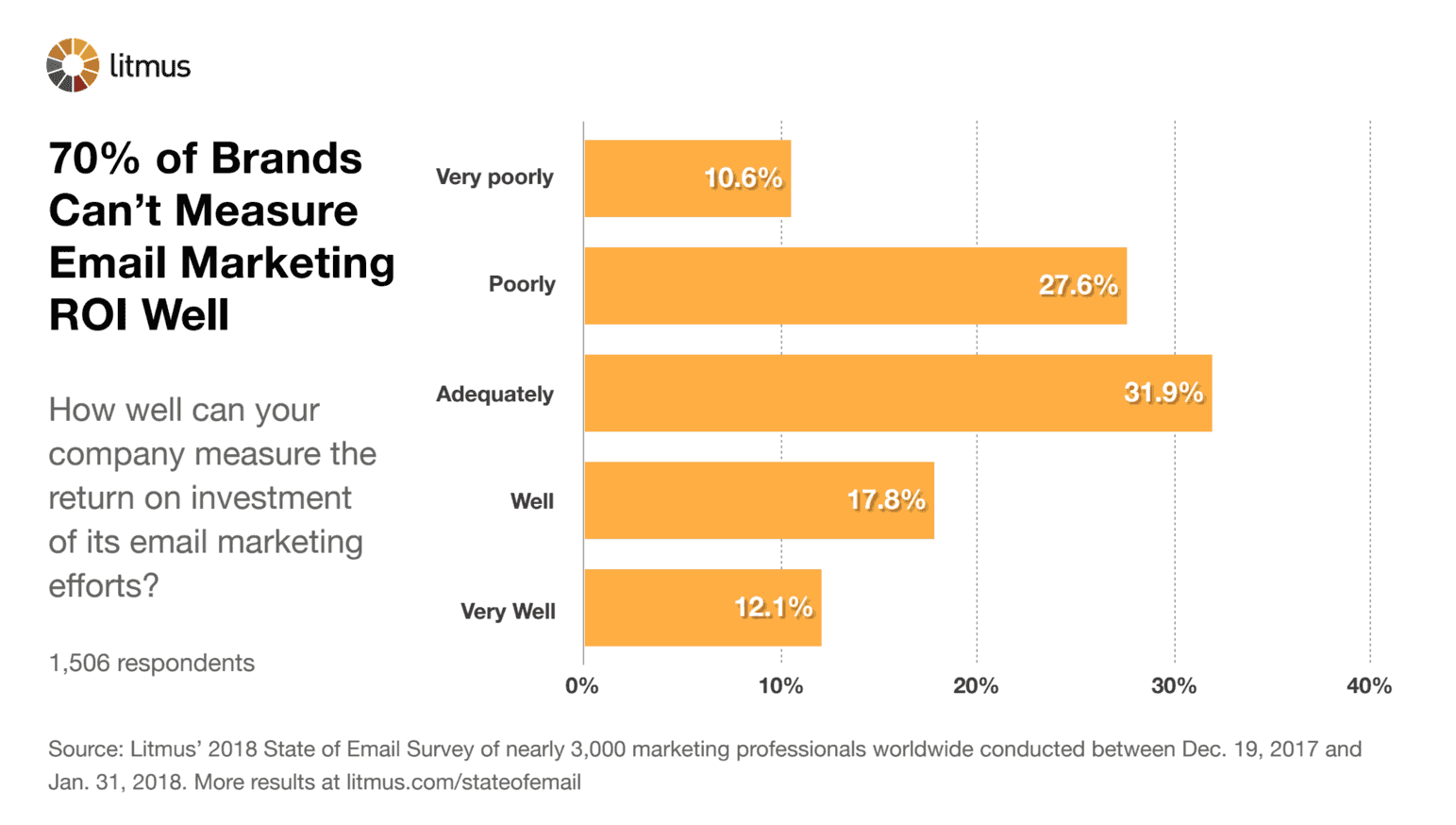
How to calculate your email ROI
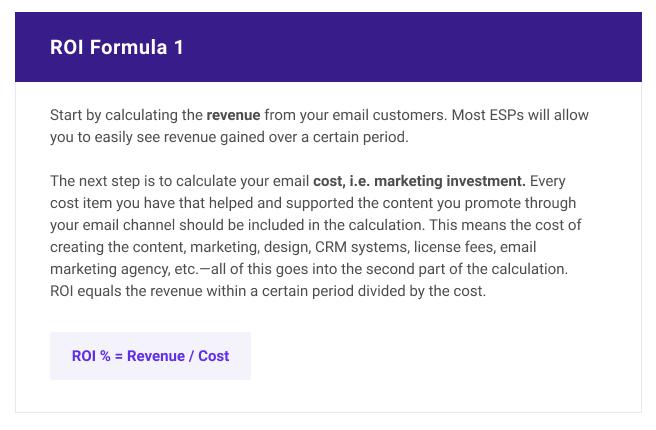
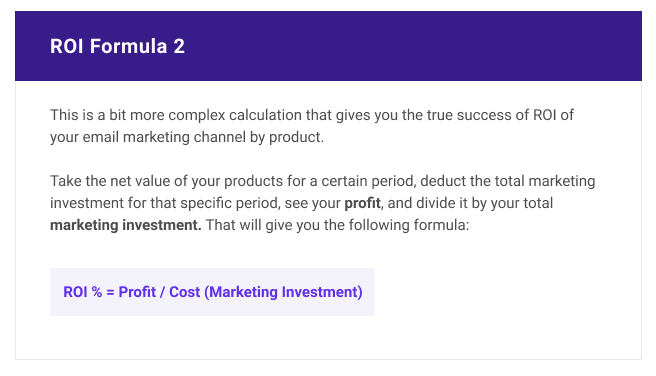
Email Marketing Laws
The never-ending quest for tighter privacy control, coupled with consumers’ aversion to aggressive marketing, resulted in strict laws against spam messages, unsolicited marketing, and other shady practices. Each country has its own act regulating email marketing communication:
- United States: American Controlling the Assault of Non-Solicited Pornography and Marketing Act (CAN-SPAM)
- Canada: Canada’s Anti-Spam Law (CASL)
- European Union: The General Data Protection Regulation (GDPR)
- Australia: Spam Act
Choose the Right Email Marketing Agency
Choosing the right (email) marketing agency for your company is never an easy task. Based on our years of experience and many clients, we compiled a list of five things to consider when you’re on the lookout for just the right partner to make your email marketing dreams come true.
1. Their Past Work: Always ask to see examples, or case studies at the very least, of the work the agency has previously done.
2. Your Budget vs. Agency Pricing: Look for an agency that has scalable services and provides quotes based on your business needs.
3. Keeps Its Work In-House: While you’re looking to outsource your email marketing efforts, it’s a bad idea to hire an agency that is looking to do the same.
4. The Kind of Content They Provide Website Visitors: If an agency’s content is stale, outdated, and just not of very good quality, you might want to move away.
5. How You Feel About Them: When all is said and done, give yourself a minute and compile all these impressions into a clear vision of how you see your partner.
 from Volusion Ecommerce Blog | SMB Marketing, Design, & Strategy https://ift.tt/2VKPrVM
from Volusion Ecommerce Blog | SMB Marketing, Design, & Strategy https://ift.tt/2VKPrVM via IFTTT
via IFTTT
No comments:
Post a Comment